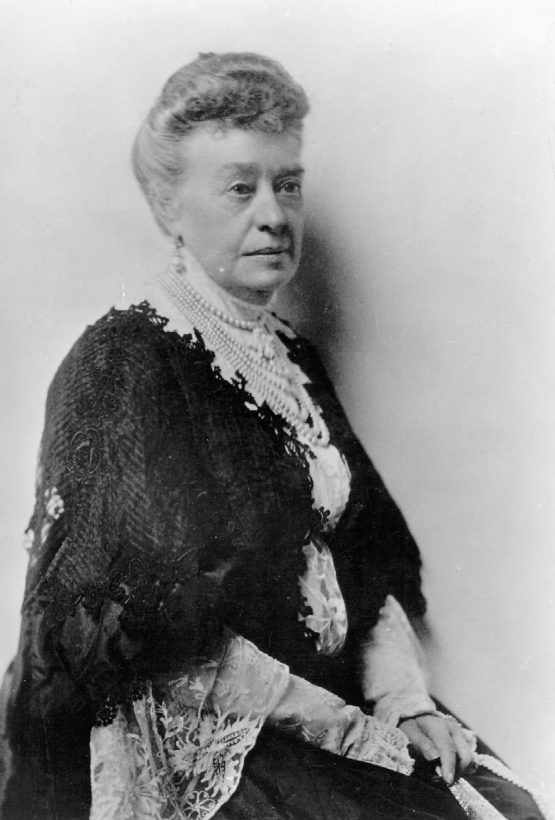Community to celebrate Jane Stanford Way on Thursday
Stanford will celebrate the renaming of Serra Mall as Jane Stanford Way from 4 to 5 p.m. Thursday, Nov. 14, in Memorial Court. All members of the Stanford community are invited.
President Marc Tessier-Lavigne and Provost Persis Drell invite all members of the campus community to a celebration marking the renaming of Serra Mall, a wide pedestrian and bicycle mall that runs along the front of the campus, as “Jane Stanford Way.”
The event will take place from 4 to 5 p.m. Thursday, Nov. 14, in Memorial Court.

Stanford’s main street has been renamed Jane Stanford Way. (Image credit: Stanford University Archives)
The ceremony will include speeches by the president and the provost, as well as an address by Caelin Marum, a co-chair of the Stanford American Indian Organization. Marum, ’21, who is studying political science and Native American studies, is a member of the Three Affiliated Tribes – Mandan, Hidatsa and Arikara Nation – in North Dakota and the Woodland Cree First Nation in Canada.
In addition to honoring Stanford University’s co-founder, Jane Lathrop Stanford (1828-1905), the event will commemorate the renaming process, initiated by members of the Native American community, that resulted in the renaming of three campus landmarks bearing the name of Father Junipero Serra, the 18th-century Spanish missionary who founded the California Mission system. For more information on the process, Stanford prepared a Q&A.
In April 2019, Stanford renamed an undergraduate residence in the Stern Hall complex as the Sally Ride House in memory of pioneering astronaut and Stanford alumna Sally Ride. In May 2019, Stanford renamed an academic building occupied by the Clayman Institute for Gender Research in honor of Stanford alumna and psychologist Carolyn Lewis Attneave, who was of Native heritage and is credited with establishing the field of Native American mental health.
The renaming of Serra Mall as Jane Stanford Way completes the renaming process. One nearby campus building, Lathrop Library, located on Memorial Way, bears her surname at birth.
Stanford’s official address became 450 Jane Stanford Way in October.
In choosing “Jane Stanford Way,” the university honors a woman who left an enduring mark on the institution she co-founded with her husband, Leland Stanford. The couple created Stanford as a memorial to their only child, Leland Jr., who died of typhoid as a teenager in 1884. The university celebrated its Opening Day in October 1891.
Plaques share history of land, university
The university will install three interpretive plaques related to the renaming: one honoring Jane Stanford and describing the history of the renaming process; another honoring the Muwekma Ohlone people, whose history is intertwined with the university’s; and a third referencing the renaming committee’s decision to retain the name Serra Street between Campus Drive East and El Camino Real.
The Jane Stanford Way plaque features photos of Jane Stanford, including one with her beloved son, as well as one of her best known quotes: “There is only one failure for you and that is not to be true to the best you know.”
The plaque also describes the renaming process, which was initiated by the Associated Students of Stanford University in 2016, when the student government passed resolutions asking the university to rename streets and buildings bearing Serra’s name, citing the mission system’s harmful impacts on Native Americans. In 2018, the Stanford University Board of Trustees accepted committee recommendations to rename three campus landmarks, including Serra Mall.
The Ohlone of the Peninsula plaque will feature photographs as well as a quote from former Muwekma Tribal Chairwoman Rosemary Cambra: “Our people, the Muwekmas, the East Bay families, have never left their lands. … They have always been here for generation after generation.”
The plaque will be installed at the entrance to Old Union.
The Ohlone of the Peninsula plaque will acknowledge that Stanford’s campus is located within the traditional territory of the Muwekma Ohlone Tribe. It will provide a short history of the Ohlone people, beginning with their resistance to the network of missions that the Spanish government established in 1769, which inaugurated an era of compulsory labor, disease and dislocation and the introduction of Christianity.
Today, Stanford and the Muwekma Ohlone Tribe are strong partners in community-led archeology, historic interpretation and a native plant garden. Also, a dedicated residential space for indigenous students is known as “Muwekma-Tah-Ruk,” or “House of the People.”
